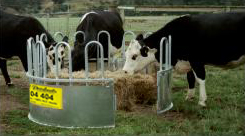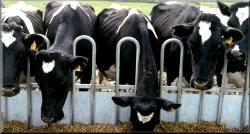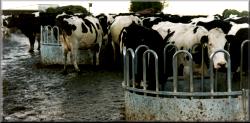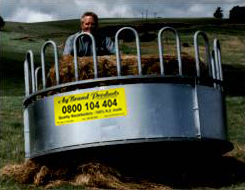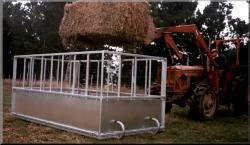Why use stock feeders?
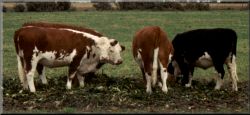 Trials have shown waste of 40 to 50% when hay & silage is spread out in paddocks. AgBrand Stock feeders are proven to reduce this waste to less than 6% and the better fed animals that result have:
Trials have shown waste of 40 to 50% when hay & silage is spread out in paddocks. AgBrand Stock feeders are proven to reduce this waste to less than 6% and the better fed animals that result have:
- Improved conception & fertility rates
- Improved growth at critical times like winter,drought & weaning
- Production increases in milk, beef, venison & sheep meat.
Which feeder is the most popular and why?
The AgBrand C6 pinned round feeder. Easily put together & quickly dismantled for storage. Will feed cattle from 5 months of age to maturity.
If I start with one feeder can I grow it into a larger one?
Most of the pinned feeders join together. The S2 Oval feeder is made of two side sections of the S1 plus two sections of C6H for the ends.
You have feed positions at 400mm intervals but some advisers say the average cow needs 700mm space?
More cows feed per metre at the AgBrand Feed Fence, even with a feed position gap of 400mm. Twelve cows on average can fit in the 15 feed positions per 6 metre length and the extra pipework makes for a very strong unit.
Cows seem content & secure when feeding as exampled by the behaviour of a 260 cow Holstein/Friesian herd fed for 6 years at a 130 metre long AgBrand feed fence. On introduction the cows took 90 minutes to eat 5kg of dry matter but the feeding time soon halved to 45 minutes once they settled into their routine. The share milker believes the cows learned that they could not be pushed out of their feeding space and as a consequence ate quicker and quieter with no hassle from herd mates.
If farmers want more feeding room per animal, we can provide the wider Bull Spaced design.
How to stop a pugged area developing around a feeder in wet weather?
Move the feeder regularly or put it on a metalled area. One farmer in the Manawatu has metalled a little further into his paddock gateways as a permanent place for his feeders, but having a stoney area as in the photo from Westland is ideal.
Can the feeders be used effectively on farm raceways?
Yes. Many dairy farmers use a couple of feeders in their races for cows to nibble on hay, straw or silage while moving to & from the milking area. A 650 cow Manawatu dairy farmer uses 8 AgBrand round feeders scattered around the farm race system. The first winter he got an extra months feeding from his stock of big hay bales.
Your feeders look suitable for the feeding of surplus vegetables and fruit to my cattle?
A Hawke’s Bay farmer tells us the S2 Oval feeder holds 4 tonne of apples, onions or potatoes and the cattle eat them all. Just pull out a pin, open one side of the feeder, back the truck up and tip in 4 tonne of crop.
Do the AgBrand feeders work as well as the Red Barns models for deer?
Yes. The odd deer will jump into a AgBrand feeder but they can just as easily jump out. The Red Barns feeders top rail is an effective barrier for keeping deer out. A Southland deer farmer wintered 40 hinds under some macrocarpa trees with a AgBrand rectangular feeder and filled it with 2 bales once every 10 to 14 days.
How durable are the feeders?
The feeders are made of galvanised high tensile steel and built to be a strong and durable product that should withstand any pressure from livestock. Pictured is a 7 year old S1 rectangular feeder used for a mob of 25 x 2 year old steers. Still solid and strong with some rust on the bottom plate but good for many more years.
Are your feeders cost effective?
Trials have shown that at least 40% more hay is eaten when a big round bale is put in a feeder. With bulk silage, consumption reduced 50% with no drop in milk production once a AgBrand feed pad was installed.
How beneficial are roofs on feeders?
If a bale in a feeder is going to be eaten in 3 or 4 days then a roof is not required. Cattle will still eat wet hay if it is clean and not fouled. We have a lot of requests for roofs but the advice we give has been honed from farmers that experimented with varied feeder models 20 to 30 years ago. Their advice “roofs are more trouble than they are worth”. If you are in a particularly wet district and a roof is necessary then we will supply it.
How do you put the bales in the feeder?
The next two pictures are examples. One with the AgBrand boss in his younger days tipping the feeder over the bale and the other with the tractor and loader.
How do you shift a feeder with a half eaten bale inside?
See the Accessories available. The feeders slot into a sled made for each particular model, as shown in photo. Problem solved!
Do feeders reduce the time spent feeding out?
Answered by a comment from a farmer with a AgBrand feeder. “I now feed twice as many cattle with half the amount of hay, and less than half the amount of time and effort”.
Any other uses for the stock feeder?
How about a temporary pen for mothering on?
How quickly can you have feeders on my farm and what is an approximate freight charge?
Speed of delivery depends on when the order is placed and for what quantity. From September to February we can deliver in less than a week if the order is for no more than four feeders. During the busy March to August period when every farmer wants them yesterday, we attempt to deliver at a weeks notice, but sometimes that is impossible.
Early ordering is a big help.
Freight charges for up to 2 round feeders are $120.00 to the North Island and $200.00 to the South Island.
For bulk orders discounts are available.
How do I order and pay?
Telephone us at Freephone 0800 104 404 to order. Invoices are sent as feeders are despatched and prompt payment is appreciated.



